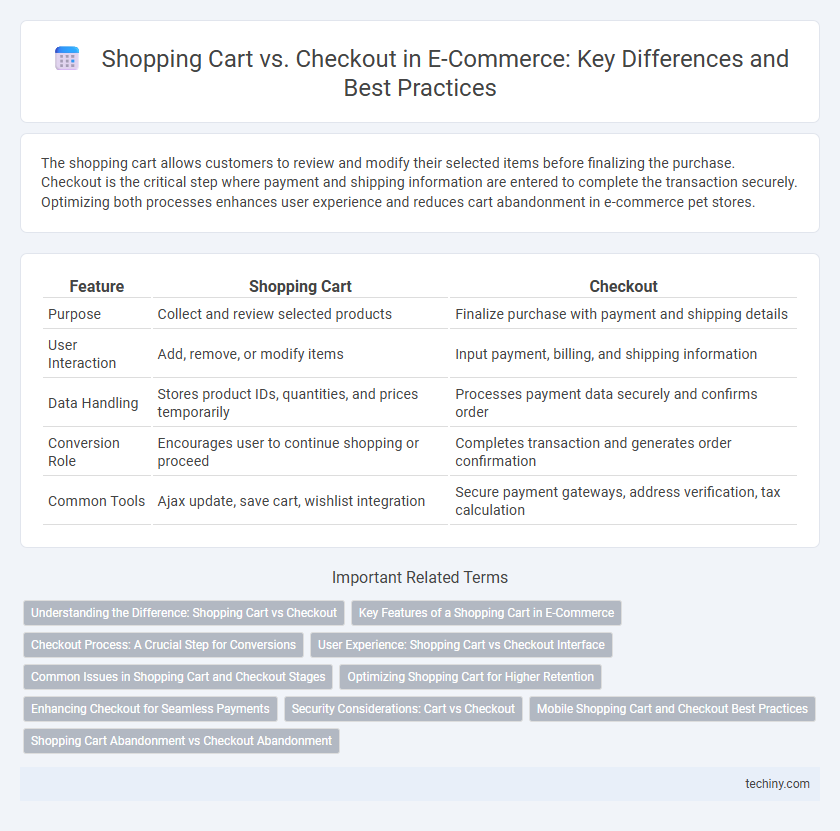The shopping cart allows customers to review and modify their selected items before finalizing the purchase. Checkout is the critical step where payment and shipping information are entered to complete the transaction securely. Optimizing both processes enhances user experience and reduces cart abandonment in e-commerce pet stores.
Table of Comparison
| Feature | Shopping Cart | Checkout |
|---|---|---|
| Purpose | Collect and review selected products | Finalize purchase with payment and shipping details |
| User Interaction | Add, remove, or modify items | Input payment, billing, and shipping information |
| Data Handling | Stores product IDs, quantities, and prices temporarily | Processes payment data securely and confirms order |
| Conversion Role | Encourages user to continue shopping or proceed | Completes transaction and generates order confirmation |
| Common Tools | Ajax update, save cart, wishlist integration | Secure payment gateways, address verification, tax calculation |
Understanding the Difference: Shopping Cart vs Checkout
A shopping cart in e-commerce serves as a virtual container where customers can add, remove, or review products before finalizing their purchase, enabling easy modifications and price calculations. The checkout process occurs after the shopping cart, guiding users through payment information, shipping details, and order confirmation to complete the transaction securely. Understanding the difference between shopping cart and checkout enhances user experience and reduces cart abandonment rates in online stores.
Key Features of a Shopping Cart in E-Commerce
A shopping cart in e-commerce serves as a dynamic tool allowing customers to add, edit, and review products before purchase, featuring real-time price updates, quantity adjustments, and saved item lists for future visits. It integrates with inventory management systems to reflect accurate stock levels and supports multiple payment options and promo code entries, enhancing user convenience. Seamless synchronization with the checkout process ensures a smooth transition, reducing cart abandonment rates and improving overall conversion.
Checkout Process: A Crucial Step for Conversions
The checkout process is a critical stage in e-commerce conversion optimization, directly impacting the final purchase decision. Streamlined checkout procedures that minimize form fields, offer multiple payment options, and ensure secure data handling significantly reduce cart abandonment rates. Enhancing the user experience during checkout leads to higher completion rates and increased revenue for online retailers.
User Experience: Shopping Cart vs Checkout Interface
The shopping cart interface enhances user experience by allowing easy access to product reviews, quantity adjustments, and price updates, helping shoppers make informed decisions before purchasing. The checkout interface prioritizes simplicity and speed, focusing on streamlined form fields, secure payment options, and clear progress indicators to reduce cart abandonment rates. Optimizing both interfaces with intuitive navigation and responsive design ensures a seamless transition from browsing to purchase, boosting overall conversion.
Common Issues in Shopping Cart and Checkout Stages
Common issues in the shopping cart stage include unexpected shipping costs and lack of clear product information, which often lead to cart abandonment. During checkout, users face problems like complicated forms, limited payment options, and slow loading times that disrupt the purchase flow. Addressing these pain points improves conversion rates and enhances overall customer satisfaction.
Optimizing Shopping Cart for Higher Retention
Optimizing the shopping cart by simplifying the layout and minimizing required fields significantly reduces cart abandonment and boosts user retention. Integrating features like saved carts, multiple payment options, and clear progress indicators encourages customers to complete their purchases. Enhanced loading speeds and real-time inventory updates further improve the shopping experience, increasing conversion rates in e-commerce platforms.
Enhancing Checkout for Seamless Payments
Optimizing the checkout process significantly reduces cart abandonment and boosts conversion rates by enabling seamless payments. Integrating multiple payment gateways, one-click payment options, and transparent cost summaries enhances user trust and streamlines the transaction flow. Mobile-friendly design and real-time error validation further improve the checkout experience, ensuring faster and more secure payments.
Security Considerations: Cart vs Checkout
Shopping cart security focuses on protecting stored user data and preventing unauthorized access or tampering before purchase completion. Checkout security involves implementing SSL encryption, secure payment gateways, and compliance with PCI DSS standards to safeguard sensitive payment information during transaction processing. Robust authentication measures and fraud detection systems are critical throughout both stages to ensure end-to-end e-commerce security.
Mobile Shopping Cart and Checkout Best Practices
Mobile shopping cart design should prioritize simplicity and easy navigation to reduce cart abandonment rates, incorporating large touch-friendly buttons and persistent cart visibility. Checkout processes must streamline form fields, enable autofill options, and support multiple payment methods, including digital wallets, to enhance conversion rates on mobile devices. Optimizing loading speeds and minimizing distractions during mobile checkout significantly improve user experience and sales completion.
Shopping Cart Abandonment vs Checkout Abandonment
Shopping cart abandonment occurs when customers add products to their cart but leave the site before initiating the checkout process, affecting up to 70% of online shoppers. Checkout abandonment happens during the final purchase steps, often due to unexpected costs or complicated forms, causing an average dropout rate of 40%. Reducing both types requires optimizing user experience, transparent pricing, and streamlined payment options to increase conversion rates.
Shopping Cart vs Checkout Infographic

 techiny.com
techiny.com